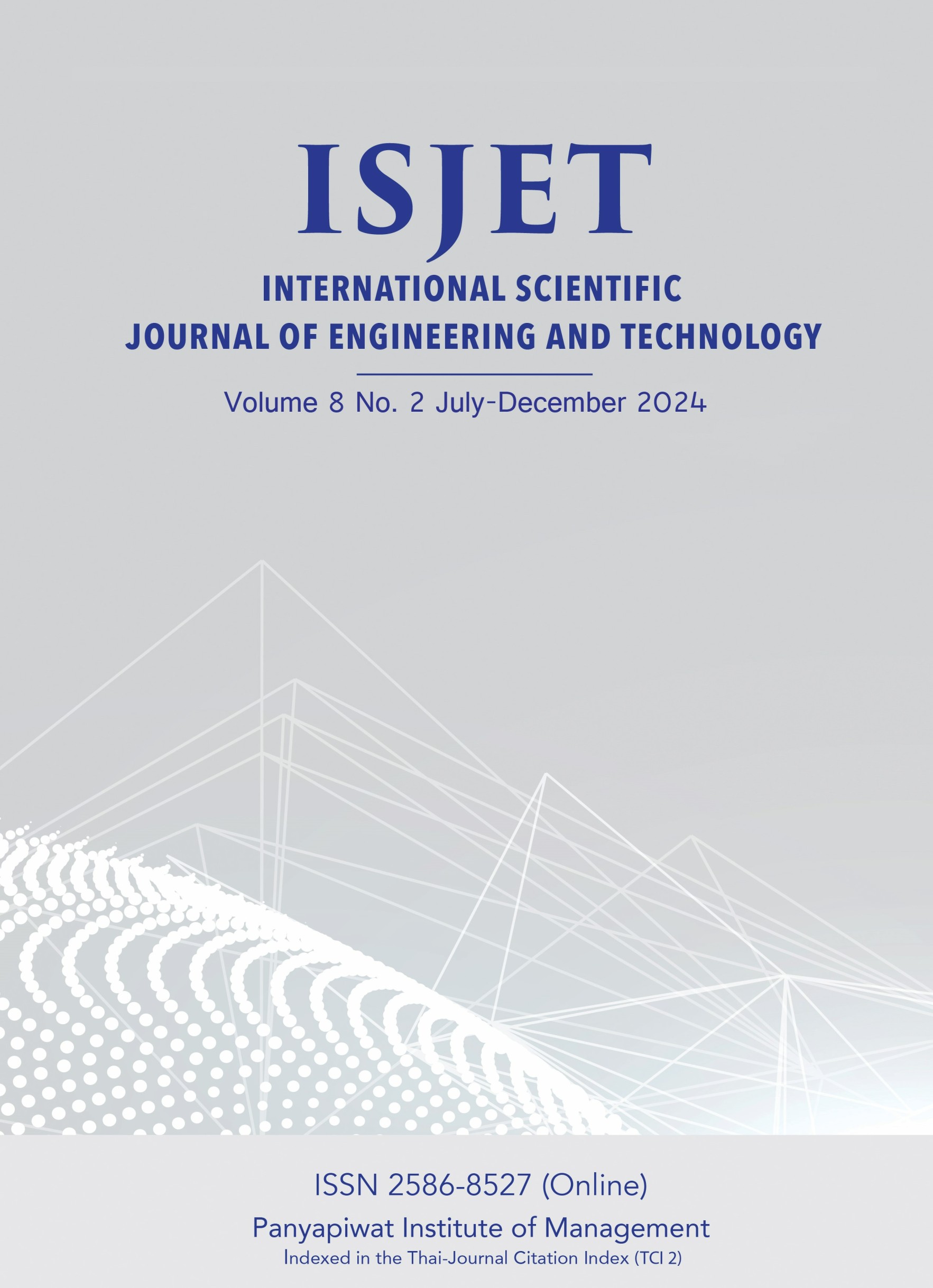Enhancing Warehouse Management with AI and Computer Vision: A Case Study in a Logistics Service Company
Main Article Content
Abstract
In the evolving landscape of warehouse management in Industry 4.0, this paper explores the convergence of Artificial Intelligence (AI) and Computer Vision (CV) for inventory tracking and stock registration. Conducted in collaboration between SIIT and KNS, a logistics
service company specializing in warehousing, the study introduces a framework that optimizes image capture conditions through real-time analysis of gyroscope values, distinguishing mobile phone movement from stationary states. Additionally, an object detection model using the YOLOv8 algorithm achieves 83% accuracy in label detection and 75% in box detection within a curated dataset. The research highlights the successful development of the phone motion detection model and Optical Character Recognition (OCR) integration. This framework promises to advance warehouse management systems by addressing current limitations with a comprehensive, efficient, and user-friendly solution.
Article Details

This work is licensed under a Creative Commons Attribution-NonCommercial-NoDerivatives 4.0 International License.
เนื้อหาข้อมูล
References
R. S. Peres, X. Jia, J. Lee et al., “Industrial Artificial Intelligence in Industry 4.0-Systematic Review, Challenges and Outlook,”
IEEE Access, vol. 8, pp. 220121-220139, Dec. 2020.
Ö. Albayrak Ünal, B. Erkayman, and B. Usanmaz, “Applications of Artificial Intelligence in Inventory Management: A Systematic
Review of the Literature,” Arch. Compute. Methods Eng., vol. 30, no. 4, pp. 2605-2625, Feb. 2023.
M. D. Capua, A. Ciaramella, and A. De Prisco, “Machine Learning and Computer Vision for the Automation of Processes in Advanced Logistics: The Integrated Logistic Platform (ILP) 4.0,” Procedia Comput. Sci, 217(9), vol. 217, no. 9, pp. 326-338. doi.org/10.1016/
j.procs.2022.12.228
M. Javaid, A. Haleem, R. P. Singh et al., “Exploring Impact and Features of Machine Vision for Progressive Industry 4.0 Culture,” Sensors Int, vol. 3, no. 5, p. 1000132, Nov. 2021. p. 100132. doi.org/10.1016/j.sintl.2021.100132
Y. Song, F. R. Yu, L. Zhou et al., “Applications of the Internet of Things (IoT) in Smart Logistics: A Comprehensive Survey,” IEEE Internet Things Journal, vol. 8, no. 6, pp. 4250-4274, Mar. 2021. doi.org/10.1109/jiot.2020.3034385
E. Zunic, S. Delalic, K. Hodzic et al., “Smart Warehouse Management System Concept with Implementation,” in Proc. 2018 14th Symposium on Neural Networks and Applications (NEUREL), 2018, pp. 1-5. doi.org/10.1109/neurel.2018.8587004
A. Vukicevic, M. Mladineo, N. Banduka et al., “A Smart Warehouse 4.0 Approach for the Pallet Management Using Machine Vision and Internet of Things (IoT): A Real Industrial Case Study,” Adv. Prod. Eng. Manag, vol. 16, no. 3, pp. 297-306, Sep. 2021. doi.org/10.14743/apem2021.3.401
R. Wudhikarn, P. Charoenkwan, and K. Malang, “Deep Learning in Barcode Recognition: A Systematic Literature Review,” IEEE Access, vol. 10, pp. 8049-8072, Jan. 2022. doi.org/10.1109/access.2022.3143033
Y. Wei, S. Tran, S. Xu et al., “Deep Learning for Retail Product Recognition: Challenges and Techniques,” Comput. Intell. Neurosci, vol. 2020, pp. 1-23, Nov. 2020.
G. Monteiro, L. Camelo, G. Aauino et al., “A Comprehensive Framework for Industrial Sticker Information Recognition Using Advanced OCR and Object Detection Techniques,” Appl. Sci., vol. 13, no. 12, p. 7320, May. 2023. doi.org/10.3390/
app13127320
S. Long, X. He, and C. Yao, “Scene Text Detection and Recognition: The Deep Learning Era,” Int. J. Comput. Vis., vol. 129, no. 1, pp. 161-184, Aug. 2020. doi.org/10.1007/s11263-020-01369-0
X. Chen, L. Jin, Y. Zhu et al., “Text Recognition in the Wild,” ACM Comput. Surv., vol. 54, no. 2, pp. 1-35, Dec. 2021. doi.
org/10.1145/3440756
X. Yang, F. Sang, T. Wang et al., “Research on the Influence of Camera Velocity on Image Blur and a Method to Improve Object Detection Precision,” in Proc. The 21 International Conference on Cyber-Physical Social Intelligence (ICCSI), 2021, pp. 1-6. doi.org/10.1109/iccsi53130.2021.9736224
I. M. Pires, N. M. García, E. Zdravevski et al., “Activities of Daily Living with Motion: A Dataset with Accelerometer, Magnetometer and Gyroscope Data from Mobile Devices,” Data Brief, vol. 33, p. 106628, Dec. 2020. doi.org/10.1016/j.
dib.2020.106628
A. Jain and V. Kanhangad, “Human Activity Classification in Smartphones using Accelerometer and Gyroscope Sensors,” IEEE Sensors Journal, vol. 18, no. 3, pp. 1169-1177, 2018. doi.org/10.1109/jsen.2017.2782492
M. Shoaib, S. Bosch, Ö. D. İncel et al., “Complex Human Activity Recognition Using Smartphone and Wrist-Worn Motion Sensors,” Sensors, vol. 16, no. 4, p. 426, Feb. 2016. doi.org/10.3390/s16040426
P. Jiang, D. Ergu, F. Liu et al., “A Review of Yolo Algorithm Developments,” Procedia Comput. Sci., vol. 199, pp. 1066- 1073, Feb. 2022.
T. Diwan, G. Anirudh, and J. V. Tembhurne, “Object Detection Using YOLO: Challenges, Architectural Successors, Datasets and Applications,” Multimedia Tools Appl., vol. 82, no. 6, pp. 9243-9275, Aug. 2022. doi.org/10.1007/s11042-022-
-y
C. H. Kang and S. Y. Kim, “Real-Time Object Detection and Segmentation Technology: An Analysis of the YOLO Algorithm,” JMST Advances, vol. 5, no. 2-3, pp. 69-76, Sep. 2023. doi.org/10.1007/s42791-023-00049-7


